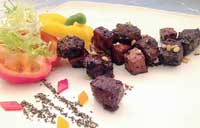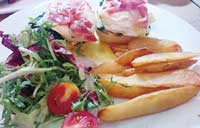Kitchen jazz
|
 |
"You will have smaller plates, and they will have to go from tray, to trolley, to truck, to elevator before they even reach the galley kitchen on the plane."
Since the meals will be heated a second time on the flight, she adds, you don't want everything to dry out. And the skin on her Spanish-style grilled chicken would lose its crispness when re-heated, for example, so the meat is slow-cooked instead of grilled, and the loose mound of slivered mushrooms she puts on top in the restaurant version goes into the sauce for in-flight diners.
But the essence of her native cuisine remains, including signature dishes such as braised osso buco with mushroom risotto, chicken stew with mushrooms and fino wine sauce, seafood paella with Spanish saffron rice and foie gras terrine, fig puree, grilled brioche in port wine balsamic.
But what about her much-loved Hollandaise sauce? No way.
"The egg and clarified butter would just separate because of the temperature change and reheating," she says. Clear sauces she favors also had to give way to heavier, more creamy versions that would stay on top of an entree through the process - and also help keep the dish moist.
The goal for the airline customer is: easy plus tasty, she says. "The people serving food on a plane can't spend four minutes fiddling with the presentation on every plate like I do in a restaurant."
This was not Pons's first experience creating an airline menu. She had a similar assignment several years ago while working at a French restaurant in Beijing.
"There are a lot of frequent flyers, especially between Beijing and Hong Kong," she says. "Those people might travel two or three times a week or maybe every Monday. You don't want to serve them the same food over and over, so the menu in business class can change every day on some flights."
Things weren't quite so hectic when she trained at a culinary school in Barcelona. After earning her diploma in 1999, she worked at several restaurants in her hometown, building her reputation. When Beijing was gearing up for the 2008 Olympic Games, she and her boyfriend Jordi Valles, also a chef, were tempted by the big buildup of hotels and fine-dining opportunities at the time. Their startup Spanish restaurant Marenostrum only lasted one year, but Pons soon found herself in the kitchen of Raffles Beijing, where she worked for four years before moving to Sureno.
Valles, meanwhile, has developed a following at the trendy Sanlitun restaurant Agua.
"We were eager to learn Chinese when we first came to Beijing, and we had the time then," she sighs. "But as we got busier, it became harder to keep the lessons going." Her "kitchen Chinese" is pretty good though as she gets plenty of practice and has little trouble communicating with her Chinese staff.
Even when she's on a short consulting job like starting a Spanish restaurant in Tibet.
"The cooks there were very excited to learn about this food," she says. "And now they make wonderful Spanish omelets!"



















